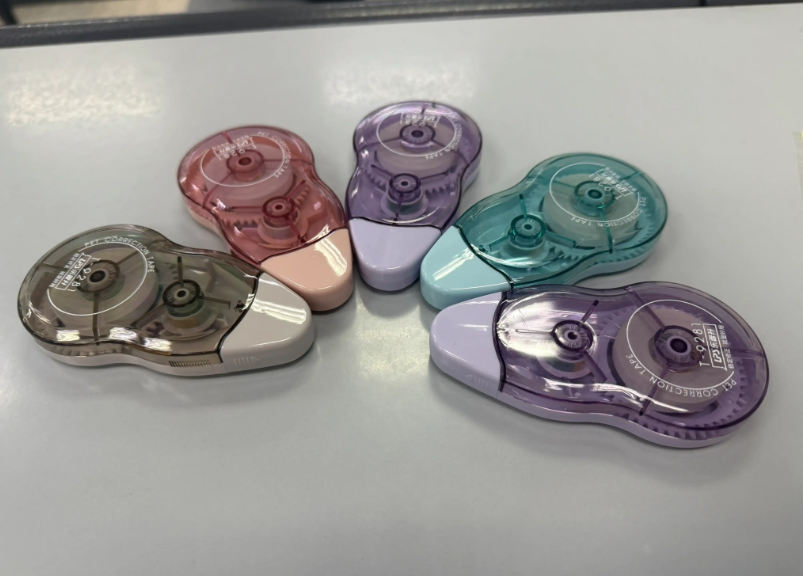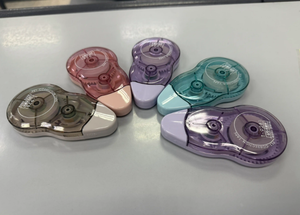
Correction of inspection methods and standards guidelines Inspection and certification services for quality inspection and factory audits
The correction tape is a white opaque writing tool similar to correction fluid. When applied to the surface of paper, it can quickly cover mistakes and allow for immediate re-writing, providing great convenience for learning and office work. This product was invented by the Japanese company SEED in 1989. Its main components include AS (acrylonitrile-styrene), PS (polystyrene), resin, titanium dioxide, etc. In terms of structure, the correction tape usually consists of upper and lower covers, a pressure nozzle, large and small gears, and a connecting body, among others. The pressure nozzle is embedded in the pressure nozzle seat at the front of the connecting body. The connecting body also has positioning pins and large and small gear shaft holes, and the gears fit together to drive the tape core to rotate.
To ensure the quality of the modified belt products, manufacturing enterprises and third-party inspection agencies usually conduct quality control based on a series of inspection standards and inspection systems. This article will systematically introduce the inspection methods for modified belts and related inspection and testing standards, covering all the key points of quality control from raw material inspection to finished product shipment.
1. Correcting with basic knowledge and quality requirements
1. Product Features
The correction tape features quick usage, environmental friendliness without any unpleasant smell, and portability. The modified position is not easily visible in copies or faxes. Some correction tapes have certain requirements for writing skills, and ballpoint pens have the best compatibility.
2. Main Components
These include titanium dioxide (TiO2), resin, polystyrene, self-adhesive glue, stripping paper, styrene-acrylonitrile copolymer (AS), etc.
3. Specifications and Packaging
The common width ranges from 4 to 6 millimeters, and the length varies from 2 meters to 50 meters. The color is mainly white, and there are also various colored models. The storage period is usually 2 to 4 years.
II. Revised inspection methods and quality control standards
To ensure that the product quality meets the international stationery safety standards and customer requirements, the factory inspection and shipment inspection should cover the following aspects:
1. Appearance and sensory inspection
Based on the appearance criteria, different components are classified and inspected according to their degree of importance.
For defects that are difficult to determine, three types of limit samples - upper limit, standard, and lower limit - can be prepared as the basis for judgment.
The inspection items include surface luster, color difference, frayed edges, stains, and print clarity, etc.
2. Structure and Assembly Quality
Check whether the engagement of the large and small gears is smooth, and whether there are any jamming or teeth loss phenomena.
Is the pressure cap installed firmly? Is the contact between the cap and the paper surface smooth?
The degree of fit between the connecting piece and the upper and lower covers, and whether there is any looseness or deformation;
Is the core properly wound? Are there any breaks, twists or overflows?
3. Performance Testing Items
Coverage test: Check the coverage effect and whiteness after the correction tape is coated.
Adhesion test: To verify whether the adhesion of the product on paper is good and whether it is prone to peeling off.
Reproducibility test: Use different writing tools such as ballpoint pens and fountain pens to check the smoothness of the writing.
Durability test: Simulates the core breakage strength after multiple uses and the wear resistance of the gears;
Environmental protection and safety testing: including detection of heavy metal content, volatile organic compounds (VOC), and assessment of children's safety.
4. Packaging and Label Inspection
Do the inner and outer packaging meet the customer's requirements and industry standards?
Whether the label information is accurate and complete, including ingredients, specifications, production date, shelf life, manufacturer information, etc.
For cartoon-style or children's style safety belts, it is necessary to conduct an additional inspection to determine if there is a risk of small parts falling off and to ensure compliance with international safety standards such as CPC and EN71.
5. Factory Audit System Review
Conduct an audit of the enterprise's quality management system (such as ISO 9001);
Production environment assessment, including cleanliness of the workshop, management of raw material storage, and rational layout of the production line;
The sampling plan usually follows the AQL standard (Acceptable Quality Level). The common levels are Level II, with Major (major defect) and Minor (minor defect) having different AQL values set respectively.
III. Summary
Although correction tapes are small items of office supplies, their quality directly affects the user experience and safety performance. Through a systematic inspection and testing process - including incoming material inspection (IQC), process inspection (IPQC), finished product inspection (FQC), and shipping inspection (OQC) - the quality of the products can be effectively controlled. Enterprises should establish a complete inspection system and cooperate with third-party factory audits and testing institutions to ensure that the products comply with national and international standards, thereby enhancing their market competitiveness.
Through the introduction in this article, readers should be able to master the core methods and standards for correction with verification, and this will provide a reference for actual inspection work.
Rewriting instructions:
Highlight the inspection and testing procedures and key terms: Industry-specific terms and steps such as "inspection", "inspection and testing", "quality control", "AQL standard", "limit samples", and "third-party testing" have been intensively incorporated, closely aligning with the quality inspection theme emphasized by the users.
Reorganize and refine the inspection contents and standards: The inspection items, methods, processes and international standards were systematically summarized and listed item by item, enhancing the clarity and professionalism.
Optimize text structure and target audience: Adjust the content sequence, strengthen the logical hierarchy, and facilitate practical application and reference for readers in fields such as quality inspection, production, and trade.
分享这个商品

Correction of inspection methods and standards guidelines Inspection a
The correction tape is a white opaque writing tool. When applied to the surface of paper, it can quickly cover up mistakes and also allows for re-writing.
